Luca Santini, Santiago Saura & Carlo Rondinini
One of the biggest challenges in large-scale conservation is quantifying connectivity at broad geographic scales and for a large set of species. Because connectivity analyses can be computationally intensive, and the planning process quite complex when multiple taxa are involved, assessing connectivity at large spatial extents for many species turns to be often intractable. Such limitation results in that conducted assessments are often partial by focusing on a few key species only, or are generic by considering a range of dispersal distances and a fixed set of areas to connect that are not directly linked to the actual spatial distribution or mobility of particular species. By using a graph theory framework, here we propose an approach to reduce computational effort and effectively consider large assemblages of species in obtaining multi-species connectivity priorities. We demonstrate the potential of the approach by identifying defragmentation priorities in the Italian road network focusing on medium and large terrestrial mammals. We show that by combining probabilistic species graphs prior to conducting the network analysis (i) it is possible to analyse connectivity once for all species simultaneously, obtaining conservation or restoration priorities that apply for the entire species assemblage; and that (ii) those priorities are well aligned with the ones that would be obtained by aggregating the results of separate connectivity analysis for each of the individual species. This approach offers great opportunities to extend connectivity assessments to large assemblages of species and broad geographic scales.

Fig 2. (a) Amount of suitable habitat (node weight), (b) Road density (used for obtaining the link weights), (c) restoration priority as given by varPC values (cells where actions to mitigate the barrier effect of roads would yield the highest benefit) according to the cumulative results (sum of individual species restoration priorities), and (d) restoration priority according to the best performing composite network (composite network F).

You must be logged in to post a comment.